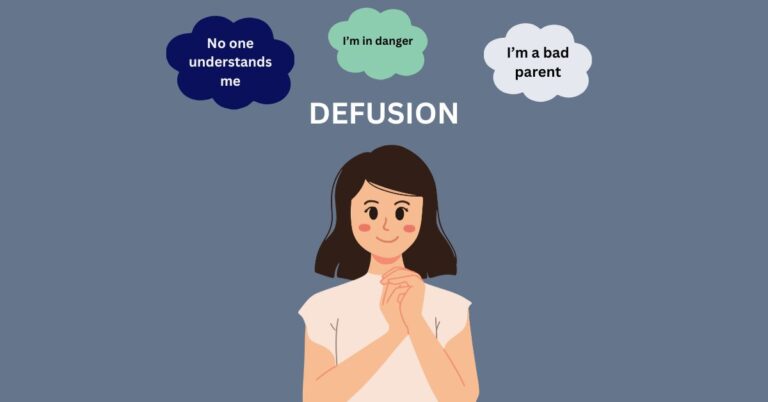Defusion Techniques
When I first read about the concept of “defusion,” I was convinced someone had made a typo (most spell-checks don’t recognize the word either!). Surely, they meant “diffusion,” right? I pictured bottling up intrusive thoughts and pressing a button to turn them into a fragrant mist. While that’s not what defusion actually is, the goal is surprisingly similar: to reposition yourself in relation to your thoughts in a way that increases psychological flexibility.
Defusion is about “de-fusing” or undoing the fusion between you and your thoughts. It’s creating even a small amount of space between you and those thoughts, giving you the freedom to respond intentionally rather than react automatically.
Psychological Flexibility
Many forms of therapy aim to increase psychological flexibility, which is our ability to stay present, align our actions with our values, and respond effectively to life’s challenges. Much of our mental health struggles stem from mental rigidity—the feeling that we’re trapped by unyielding internal rules.
Think about the rules you carry around in your mind, some of which may have been with you since childhood:
- “If my kids misbehave, I’m a bad parent.”
- “A responsible adult always has a clean house.”
- “If someone is angry at me, I must be unlovable.”
These rules often arise from past experiences, shaping how we see ourselves and the world. While they can motivate us, their rigidity can also lead to unnecessary stress and conflict. For example, if a parent believes that their child’s misbehavior means they’re a failure, they might respond in ways that don’t align with their values as a compassionate caregiver.
Defusion helps loosen the grip of these rules by shifting us from being the object of our thoughts to being the observer of them. This subtle shift can reduce the pressure of these internal demands and give us more freedom to act in ways that align with our values.
Let’s look at how this applies to OCD.
How Defusion Works in OCD
When we fuse with intrusive thoughts, it’s like standing nose-to-nose with a giant billboard. The thought dominates our mental space, leaving no room to see anything else. Defusion allows us to take a step back, creating space to observe the thought instead of being overwhelmed by it.
For someone with OCD, intrusive thoughts—those “what if” fears—often feel vivid, distressing, and impossible to dismiss. For example, a person might think, “What if I forgot to lock the door and something terrible happens?” This thought can lead to compulsive checking, which provides temporary relief but reinforces the cycle of anxiety.
By practicing defusion, the person can learn to see this thought as just a mental event, not a command to act. This process isn’t about eliminating the thought but reducing its power to control behavior. Practicing defusion is like building a muscle—it takes repeated effort, but over time, it becomes more natural and effective.
Defusion Techniques
Here are three practical defusion techniques to try:
- “Thank You, Mind”
Acknowledge your intrusive thoughts with humor or neutrality.
- Example: When the thought “I’m going to fail” arises, respond with, “Thank you, mind, for pointing that out!” Then, refocus on what you were doing.
- Why it works: This shifts the tone from fear to curiosity or humor, helping to reduce the thought’s emotional weight.
- Labeling Thoughts + Character Voice
Notice the thought and externalize it by imagining it being said by a character.
- Example: Instead of thinking, “I’ll never succeed,” say, “Oh, here’s my inner critic saying, ‘You’ll never succeed!’”; you can even play with the voice a bit to gain even more distance.
- Why it works: Labeling creates distance from the thought, while the changing of voice can make it feel less personal and threatening.
- Leaves on a Stream
Visualize each thought as a leaf floating down a stream.
- Example: Close your eyes, imagine a peaceful stream, and place each thought on a leaf as it drifts away. No need to push the leaf—just let it float.
- Why it works: This mindfulness-based exercise fosters non-attachment to thoughts, helping you observe them without engaging.
Conclusion
Defusion isn’t about getting rid of intrusive thoughts—it’s about changing how you relate to them. By practicing techniques like “Thank You, Mind,” labeling thoughts, or visualizing them as leaves on a stream, you can start to loosen their grip and reclaim your ability to respond intentionally.
Psychological flexibility is at the heart of this process. When we create space between ourselves and our thoughts, we’re no longer trapped by rigid rules or overwhelmed by mental noise. Instead, we’re free to make choices aligned with what truly matters to us.
Like any skill, defusion takes time and practice. But with patience and curiosity, you can develop a new relationship with your thoughts—one that gives you more freedom, clarity, and control.
